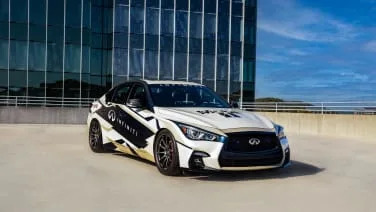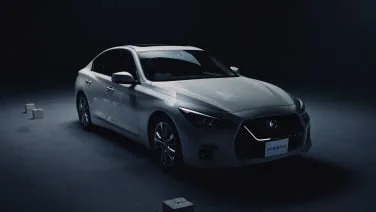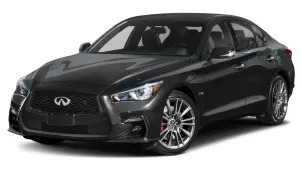2021 INFINITI Q50
There isn’t much reason to take another look at the 2021 Infiniti Q50 Red Sport 400 on the surface. It’s largely the same sedan as it was when we drove it in 2016: powerful and stylish, but lacking in tech and polish. However, what’s under the hood is of far more interest to us today than it was just a year ago. That’s because the 3.0-liter twin-turbo V6 powering this Infiniti is migrating over to the next Nissan Z car. Nissan announced that the production Z would get a 3.0-liter twin-turbo V6 not long after it revealed the Z Proto. There are no other twin-turbo V6s in Nissan’s arsenal but this one, meaning that the VR30DDTT engine in this Infiniti is destined for the Z — plus, there's photo confirmation. The big question remaining is: How new or different will it be? Its most potent state of tune is rated at 400 horsepower and 350 pound-feet of torque. That’s a high number versus most other boosted six-cylinders, and perhaps most importantly, it’s more potent than the 382-horsepower 2021 Toyota GR Supra 3.0. As we’ll soon explain, though, numbers only tell part of the story. Transplanting the Infiniti’s V6 into the next Z surely won’t be without challenges, either. Nissan is promising a six-speed manual in the Z. Meanwhile, this engine is exclusively paired with a traditional seven-speed automatic transmission in the Q50 and Q60. Nissan hitched this engine up with a manual in a 370Z SEMA show car years ago, but now it must devise a production car solution. There’s also the question of whether Nissan will use the same seven-speed as the automatic option in the Z, or come up with something a bit more aggressive. The cost-efficient (and likely) solution would be reusing the seven-speed, not unlike the Supra's eight-speed traditional automatic. Having all of this in mind, we set out to see how this engine sits today as a preview to the Z. Going from the big, naturally aspirated VQ series V6 to a smaller twin-turbo V6 will bring about the obvious changes. The rabid and uncouth personality of the outgoing VQ is nowhere to be found in the sweet and smooth new engine. It’s not quite the silky, effortless BMW inline-six found in the Supra, but it brings an air of refinement and maturity that's simply not there in the current Z. And then there’s the torque. All 350 pounds of twist are available at 1,600 rpm in the Q50 Red Sport 400, which means the shove in the back would theoretically start just off idle. In reality, the Q50 feels as though it’s limiting torque output in low gears from a standstill, resulting in the sensation of a bogged down start in any takeoff that doesn’t involve brake torqueing it for a simulated launch. A great wall of torque arrives quickly once the revs get up, extending all the way to 5,200 rpm. It has that effortless and excessive feeling of power for mundane driving …
Full Review
There isn’t much reason to take another look at the 2021 Infiniti Q50 Red Sport 400 on the surface. It’s largely the same sedan as it was when we drove it in 2016: powerful and stylish, but lacking in tech and polish. However, what’s under the hood is of far more interest to us today than it was just a year ago. That’s because the 3.0-liter twin-turbo V6 powering this Infiniti is migrating over to the next Nissan Z car. Nissan announced that the production Z would get a 3.0-liter twin-turbo V6 not long after it revealed the Z Proto. There are no other twin-turbo V6s in Nissan’s arsenal but this one, meaning that the VR30DDTT engine in this Infiniti is destined for the Z — plus, there's photo confirmation. The big question remaining is: How new or different will it be? Its most potent state of tune is rated at 400 horsepower and 350 pound-feet of torque. That’s a high number versus most other boosted six-cylinders, and perhaps most importantly, it’s more potent than the 382-horsepower 2021 Toyota GR Supra 3.0. As we’ll soon explain, though, numbers only tell part of the story. Transplanting the Infiniti’s V6 into the next Z surely won’t be without challenges, either. Nissan is promising a six-speed manual in the Z. Meanwhile, this engine is exclusively paired with a traditional seven-speed automatic transmission in the Q50 and Q60. Nissan hitched this engine up with a manual in a 370Z SEMA show car years ago, but now it must devise a production car solution. There’s also the question of whether Nissan will use the same seven-speed as the automatic option in the Z, or come up with something a bit more aggressive. The cost-efficient (and likely) solution would be reusing the seven-speed, not unlike the Supra's eight-speed traditional automatic. Having all of this in mind, we set out to see how this engine sits today as a preview to the Z. Going from the big, naturally aspirated VQ series V6 to a smaller twin-turbo V6 will bring about the obvious changes. The rabid and uncouth personality of the outgoing VQ is nowhere to be found in the sweet and smooth new engine. It’s not quite the silky, effortless BMW inline-six found in the Supra, but it brings an air of refinement and maturity that's simply not there in the current Z. And then there’s the torque. All 350 pounds of twist are available at 1,600 rpm in the Q50 Red Sport 400, which means the shove in the back would theoretically start just off idle. In reality, the Q50 feels as though it’s limiting torque output in low gears from a standstill, resulting in the sensation of a bogged down start in any takeoff that doesn’t involve brake torqueing it for a simulated launch. A great wall of torque arrives quickly once the revs get up, extending all the way to 5,200 rpm. It has that effortless and excessive feeling of power for mundane driving …
Hide Full Review
Hide Full Review
Retail Price
$36,700 - $57,850
MSRP / Window Sticker Price
| Engine | 3.0L V-6 |
| MPG | Up to 20 city / 29 highway |
| Seating | 5 Passengers |
| Transmission | 7-spd auto w/OD |
| Power | 300 - 400 hp |
| Drivetrain | all wheel, rear-wheel |
| Curb Weight | 3,685 - 3,998 lbs |
Smart Buy Program is powered by 






